![]() 1st Battalion 22nd Infantry
1st Battalion 22nd Infantry ![]()
SGT Grover C. Hart
G Company 22nd Infantry
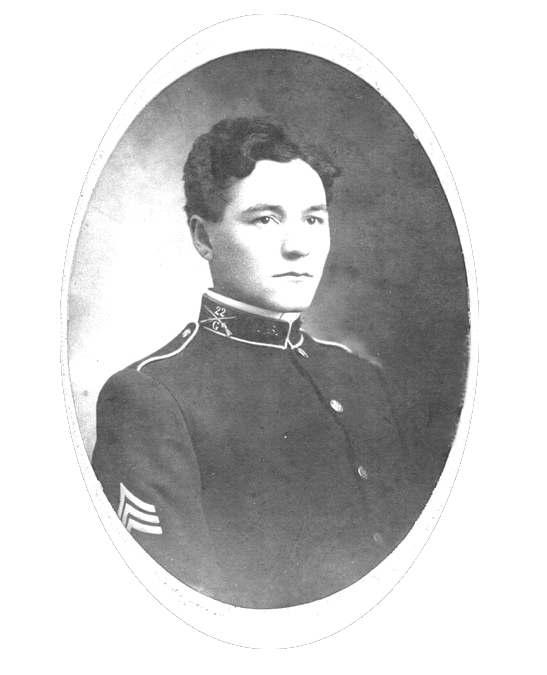 |
SGT Grover C. Hart In a formal portrait SGT
Hart is seen wearing on his collar |
A studio portrait of SGT Hart. His dress uniform includes a 1902 model
dark blue coat |
|
Grover C. Hart enlisted in the
US Army in Kansas City, Missouri, on December 1, 1904.
Born in Port Washington, Ohio, he was 21 years old at the time of
his enlistment,
was not married and had been a Lineman for the railroad.
He spent three years in the 22nd
Infantry Regiment, enduring the arduous campaigns and fighting
of the Philippines Insurrection and served with distinction
during the relief efforts and riot duty
performed by the Regiment after the San Francisco earthquake of
1906.
He was promoted to the rank of
Corporal, then Sergeant, and finally Quartermaster Sergeant
during his time in the 22nd Infantry.
His Army record shows special
notice of his service during the Mindanao campaign
of 1902-1905, where he took part in the final engagement which
eliminated the Datu Ali,
the Moro warlord whose defeat is considered to have ended the
Insurrection.
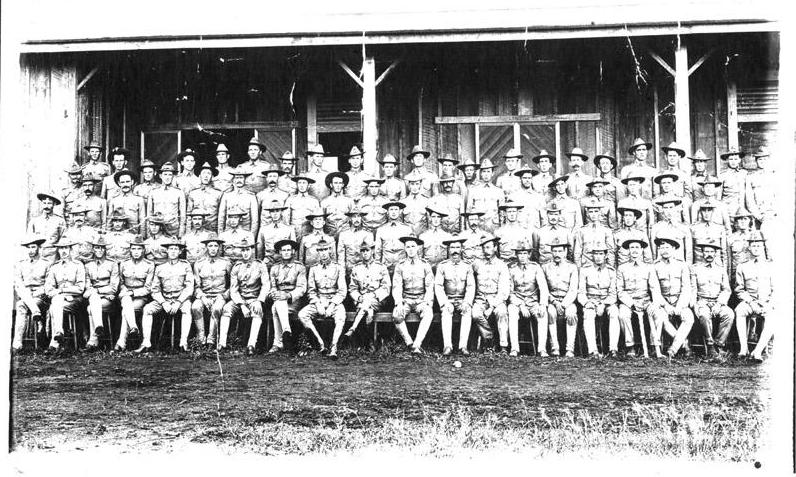
The Provisional Company of of the 22nd
Infantry, October, 1905.
G.C. Hart is on the bottom
row, 4th from the left.
On October 5, 1905, Captain F.R.
McCoy of the 3rd Cavalry, and Aide De Camp to General Leonard
Wood,
formed the above Provisional Company consisting of volunteers
from the 22nd Infantry,
specifically to go after the Moro chieftain called the Datu Ali,
who was the last major chieftain to oppose
American sovereignty on the island of Mindanao. Ali consistently
raided local villages,
conducted hit and run attacks on US camps, and continued his
campaign of insurrection through terror and fear.
In September of 1905, General Wood received intelligence that Ali
was encamped on his ranch deep in the mountains
along the Malola (Malala) River. Wood ordered that an assault
force be raised to find and apprehend the Datu.
A large number of volunteers arose from the Regiment for the
dangerous assignment, and from those volunteers
Captain McCoy hand-picked 100 men. They became the Provisional
Company pictured above,
commanded by Captain McCoy and Lieutenant Remington.
The Company travelled by boat to
Digas, on the coast of the Davao Gulf. Upon landing on the 16th
Of October,
they were joined by 10 Filipino Scouts and began the hazardous
journey into the interior.
They crossed the jungle covered mountains in five days, reaching
Ali's encampment
in the early morning hours of October 22. Quickly and quietly
they surrounded the ranch buildings
and waited. As the sun rose, Ali and a dozen of his men came out
of the main house unsuspecting and unarmed.
Lt Remington sent one squad forward and another around to the
rear of the house.
Ali ran back inside and armed himself and began firing at the
Americans. A bullet just missed Remington
but hit and killed Private Bobbs. Remington then charged into the
house firing his pistol,
hitting Ali and knocking the man down. Staggering to his feet,
Ali ran through the back door,
only to be cut down by a hail of bullets from the waiting second
squad.
With the death of Datu Ali,
organized insurrection on a major scale ended. Though armed
resistance would continue
by several Moro leaders over the next six years, the major
battles and campaigns of the Insurrection
could now be considered to be over.
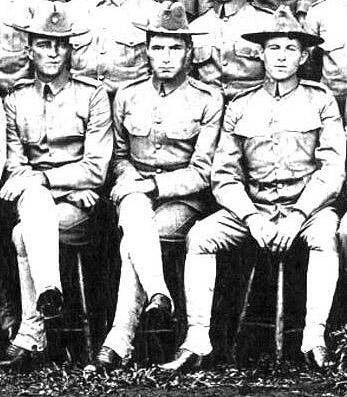
Grover Hart is center of photo, with the Provisional Company 22nd Infantry.
Grover's son recalls his father's memories of the expedition against Datu Ali:
As stated before, he observed
that many soldiers discarded equipment
to lighten loads on the way - they shot wild pigs (those w/big
tusks of which he saved one) for eating.
On the way, it was essential to build a protective
"surround" at night
which consisted of a high pile of impenetrable thicket type brush
around the encampment.
This was provided with only one way in and out -
you had to crawl out which would also slow down anyone coming in.
He said that the soldiers drew lots for guard duty outside this
"surround"
& he drew the "long" lot one night which excused
him from duty.
Two other soldiers drew "short' lots. They had their
heads cut off
when they emerged from the end of the "tunnel" by Moros
waiting outside.
Whether these Moros were associated with Datu Ali or not, I don't
know.
If he'd drawn a "short" lot, you wouldn't be reading
this.
He didn't talk much about the fight and never elaborated on it.
He observed that Datu Ali ended up in a kneeling position, face
down (prayer position).
He said that it was customary for these natives to chew
"betel nut"
which stained their teeth dark red - it was a mild narcotic
& maybe an adjunct to "running amok" which they
often did -
He also said that one of the soldiers was shot in the leg
(groin) with a bullet from a rifle such as the one he brought
back -
whether he was a survivor or not I don't know.
**********************
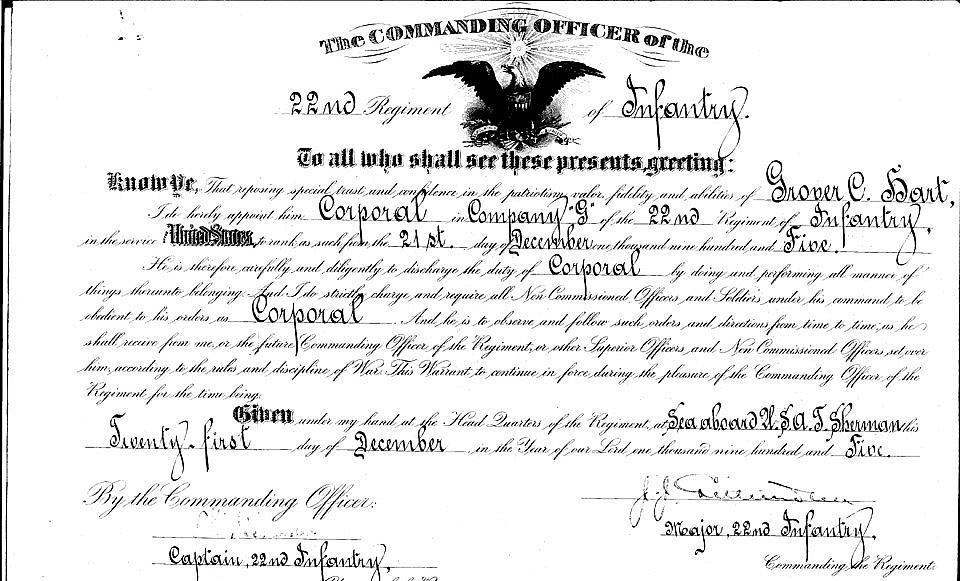
Grover C. Hart's promotion orders to
Corporal,
date of rank occuring on board the US Army Transport Ship
Sherman,
during the sea voyage back to San Francisco in December of 1905.
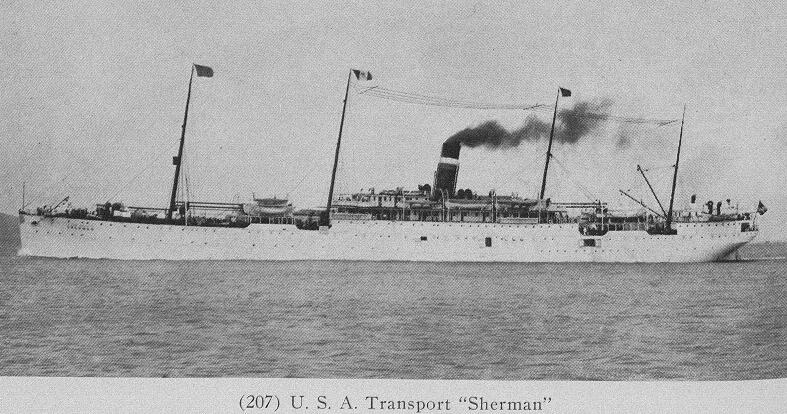
U. S. Army Transport (USAT)
"Sherman",
on which the 22nd Infantry Regiment returned to the United States
in 1905.
It was on this ship that Grover Hart was promoted to Corporal.
Details of the expedition against the Datu Ali
taken from the book:
Combat Diary by A. B. Feuer
All photos are copyright © Michael Belis 2004 on behalf of the 1st Battalion 22nd Infantry Website
Home | Photos | Battles & History | Current |
Rosters & Reports | Medal of Honor | Killed
in Action |
Personnel Locator | Commanders | Station
List | Campaigns |
Honors | Insignia & Memorabilia | 4-42
Artillery | Taps |
What's New | Editorial | Links |